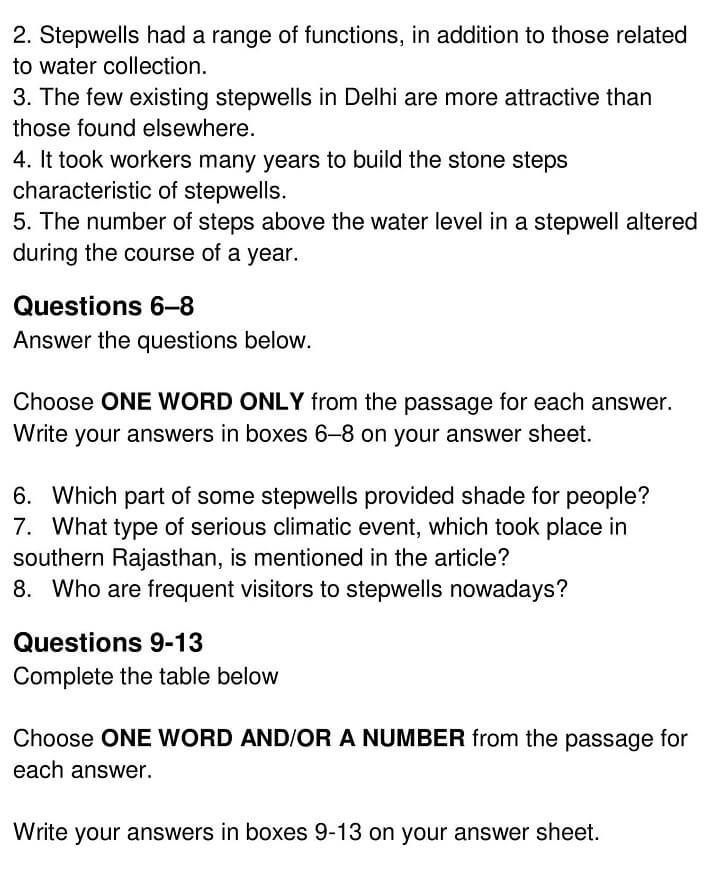Stepwells IELTS Reading Answers

Limited-Time Offer : Access a FREE 10-Day IELTS Study Plan!
The Academic passage ‘Stepwells’ is a reading passage that appeared in an IELTS Test.
It contains some of the IELTS reading question types. If you are interested in familiarising yourself with all the question types, don’t hesitate to take an IELTS reading practice test.
Stepwells






Answers
Unlock Answers
| Question number | Answer | Explanation |
|---|---|---|
| 1 | FALSE | Paragraph B mentions that the stepwells are unique to the region (dry areas of India) and are often architecturally complex and vary widely in size and shape. Most ‘stepwells’ are found dotted around the desert areas of ‘Gujarat’ (where they are called vav) and ‘Rajasthan’ (where they are known as baori), while a few also survive in ‘Delhi’. As the statement contradicts the information, the answer is FALSE. |
| 2 | TRUE | The last sentence of paragraph A informs that the significance of this invention- ‘the stepwell – goes beyond its utilitarian application’. Later, in paragraph B, it is added that during their heyday, they were ‘places of gathering, of leisure, of relaxation and of worship for villagers’ of all but the lowest castes. Some were located in or near villages as ‘public spaces for the community’; others were positioned beside roads as ‘resting places for travellers’. As the statement agrees with the information, the answer is TRUE. |
| 3 | NOT GIVEN | In paragraph B, it is written that most stepwells
are found dotted around the desert areas of Gujarat (where they are called vav) and Rajasthan (where they are known as baori), while a few also survive in Delhi. There is no further description of these stepwells and so, no comparison is provided. Hence, the answer is NOT GIVEN. |
| 4 | NOT GIVEN | In paragraph C, it is stated that stepwells comprise a ‘series of stone steps’ (stone step characteristic of the stepwell) descending from ground level to the water source as it recedes following the rains. Further, in paragraph D, it is added that some wells are vast, ‘open craters with hundreds of steps’ paving each sloping side, often in tiers. Others are more elaborate, with ‘long stepped passages’ leading to the water via several storeys built from stone and supported by pillars, they also included pavilions that sheltered visitors from the relentless heat. Although there are references to stone steps characteristic of the stepwell, there is no mention of workers or the time it was taken to build. Hence, the answer is NOT GIVEN. |
| 5 | TRUE | Paragraph C points out that the stepwells comprise a series of stone steps descending from ground level to the ‘water source as it recedes following the rains’. When the ‘water level was high, the user needed only to descend a few steps’ to reach it; ‘when it was low, several levels would have to be
negotiated’. So, during the year, the water level fluctuated. As a result, the number of the steps above water also changed during the year. As the statement agrees with the information, the answer is TRUE. |
| 6 | pavilions | Paragraph D informs that some stepwells are more elaborate, with long stepped passages leading to the water via several storeys built from stone and supported by pillars, they also included ‘pavilions’ that ‘sheltered visitors from the relentless heat’ (provide shade for people). Hence, the answer is ‘pavilion’. |
| 7 | drought | Paragraph E mentions that down the centuries, thousands of wells were constructed
throughout northwestern India. Their condition hasn’t been helped by ‘recent dry spells’, for example, ‘southern Rajasthan’ suffered an ‘eight-year drought’ between 1996 and 2004. Hence, the answer is ‘drought’. |
| 8 | tourists | In paragraph L, the writer writes that ‘today’ (nowadays),many of these monuments have been saved by the Archaeological Survey of India. ‘Tourists’ flock ‘to wells in far-flung corners of northwestern India’ to gaze in wonder at ‘these architectural marvels’ (stepwells) from 1,000 years ago, which serve as a reminder of both the ingenuity and artistry of ancient civilisations and of the value of water to human existence. Hence, the answer is ‘tourists’. |
| 9 | earthquake | Paragraph G brings out the fact that in Patan, the state’s ancient capital, the ‘stepwell of Rani Ki Vav’ (Queen’s Stepwell) is perhaps the finest current example. Incredibly, in January 2001, this ancient structure survived a devastating earthquake that measured 7.6 on the Richter scale. Hence, the answer is ‘earthquake’. |
| 10 | sides | Paragraph H gives another example of stepwells which is the ‘Surya Kund’ in Modhera, northern Gujarat, next to the Sun Temple, built by King Bhima I in 1026 to honour the sun god Surya. It’s actually a tank (kund means reservoir or pond) rather than a well, but displays the hallmarks of stepwell architecture, including ‘four sides of steps’ that ‘descend to the bottom in a stunning geometrical formation’. Hence, the answer is ‘sides’. |
| 11 | Tank | Paragraph H tells that the ‘Surya Kund’ in Modhera, northern Gujarat, built by King Bhima I in 1026 to honour the sun god Surya is another example of stepwell. It’s actually a tank (kund means reservoir or pond) rather than a well. Hence, the answer is ‘tank’. |
| 12 | verandas | Paragraph J tells that in the old ruined town of Abhaneri, about 95 kilometres east of
Jaipur, is ‘Chand Baori’, one of ‘India’s oldest’ and deepest wells, aesthetically, it’s perhaps ‘one of the most dramatic’. On the fourth side of the Chand Baori, ‘covered verandas’ supported by ornate pillars ‘overlook the steps’. Hence, the answer is ‘verandas’. |
| 13 | underwater | Paragraph K informs about ‘Neemrana Ki Baori’, located just off the Jaipur-Dehli highway. Constructed in around 1700, it’s nine storeys deep, with the ‘last two levels underwater’. At ground level, there are 86 colonnaded openings from where the visitor descends 170 steps to the deepest water source. Hence, the answer is ‘underwater’. |
Check More IELTS Reading Answers
Also check :
Practice IELTS Reading based on question types

Start Preparing for IELTS: Get Your 10-Day Study Plan Today!
Explore other Reading Topics

Janice Thompson

Janice Thompson
Recent Articles

Kasturika Samanta

Kasturika Samanta

Janice Thompson







Post your Comments